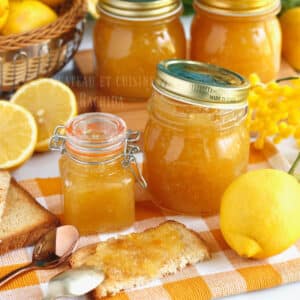
Easy lemon jam
A delicious, easy lemon jam that's neither bitter nor too acidic. Perfect for spreading on pancakes or toast.
PRINT
PIN
SAVE
INGREDIENTS
- 1.2 kg (42 oz) lemons only 28 oz will be kept after the first cooking)
- 560 g granulated sugar (19.75 oz)
- 300 ml water (10 fl oz)
PREPARATION
- The day before, start by scrubbing the lemons and placing them in the pot. Cover with water and bring to the boil.
- Cook for 15 minutes, then drain in a colander.
- Refresh under running water and return to the pot. Cover with water, bring back to the boil and cook for 15 min after boiling.
- Please note:Cooking time will depend on the thickness of the lemon skin. Stop cooking as soon as the skin begins to split, as in the last image in the photo montage below.
- Drain, refresh under running water and return to the pot. Cover with cold water and leave overnight.
- The next day, drain the lemons and cut them in half to remove the pulp. Place the pulp in a sieve to retain the seeds. No need to save the seeds to put them in cheesecloth and cook them in the jam.
- If you didn't know, the seeds are a concentrate of pectin, and it's pectin that helps make jam jellify. Lemon pulp and peel are rich in pectin, so there's no need to keep the seeds.
- Weigh the pulp and add the necessary amount of diced lemon peel to reach a total weight of 800 g.
- Pour into a pot, add sugar and water and mix well.
- For this jam I use a ratio of 1kg net fruit / 700g sugar. Use the table of 3 to find out how much sugar you'll need for the amount of net fruit used.
- Bring to a boil over medium heat and cook for 15 minutes.
- To prevent scum from forming on the surface while your jams are cooking, add 2 knobs of butter.
- Crush during cooking with a puree crusher, to refine the texture of the jam if you don't like lumps in it.
- Remove from heat and immediately fill jars almost to the brim. Replace the lids and screw on tightly.
- Turn the jars upside down on a towel and leave to cool.
- By filling the jars almost to the brim with hot jam and turning them upside down, the heat will sterilize the remaining empty space.
- Once cooled, return the jars to their original positions.
- Store jars in a dry, dark place for up to 1 year.
Notes
You can tell if the jam has been stored correctly by opening the jar. You'll have a hard time unscrewing the lid.
I heat it slightly over the fire, swirling it around. When you unscrew the lid, you'll hear a "poc" sound.
After opening, store in the refrigerator.